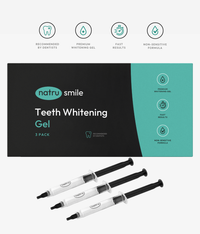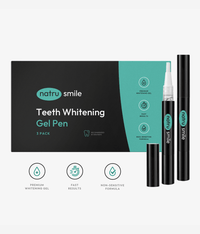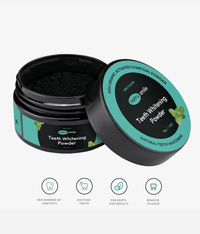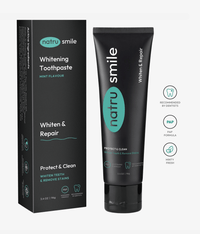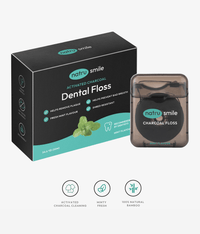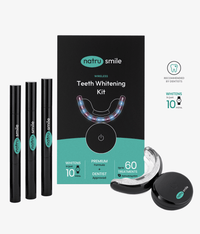
All products are certified by dental expert Dr. Greg Grillo
A brilliant set of pearly whites is a coveted asset, and professional teeth whitening offers a straightforward way to improve your smile. With an array of teeth whitening options available, this comprehensive guide delves into the ins and outs of in-office dental whitening, providing you with a detailed look at this popular cosmetic treatment.
Teeth Whitening Methods: Comprehensive Overview
Teeth whitening methods offer various options for those seeking a brighter smile. These methods generally fall into two categories: at-home and in-office.
At-Home Teeth Whitening
At-home teeth whitening provides a convenient and affordable option for those who prefer to whiten their teeth in the comfort of their own home. This category includes:
- Over-The-Counter Strips: Thin, flexible strips coated with a whitening gel that adheres to the teeth for a set amount of time.
- Gels: Teeth Whitening gels applied directly to the teeth using a small brush or incorporated into trays for even coverage.
- Trays: Pre-filled or customizable trays filled with a whitening gel that are worn over the teeth for a specified duration.
- Natural Teeth Whitening Remedies: DIY methods, such as activated charcoal or baking soda, that may provide mild whitening effects.
While at-home methods are typically more affordable, they may not deliver the same dramatic results as in-office procedures.
In-Office Teeth Whitening
In-office teeth whitening involves professional treatments administered by a dentist, which often produce faster and more noticeable results compared to at-home methods. These treatments include:
- In-Office Dental Whitening: A dentist applies a high-concentration whitening gel to the teeth and may use a specialized light or laser to accelerate the process.
- Laser Treatments: The dentist uses a laser to activate a photosensitive whitening gel, resulting in rapid and effective whitening.
- Custom-Fitted Trays: The dentist creates custom-fitted trays filled with a professional-grade whitening gel for patients to use at home under their supervision.
These professional in-office teeth whitening treatments offer faster and more noticeable results than at-home methods.
Advantages Of Professional Teeth Whitening
Opting for professional teeth whitening offers several benefits over at-home alternatives, such as:
- Speed And Efficacy: In-office whitening provides quicker and more dramatic results, with many patients noticing a significant improvement after just one visit.
- Customized Treatments: Dentists can tailor the whitening process to suit individual needs, taking into account factors like tooth sensitivity and the level of discoloration.
- Supervised Care: With in-office treatments, dental professionals monitor the process, reducing the likelihood of complications or errors and ensuring optimal results.
- Longevity: Professional treatments tend to have more lasting effects than at-home methods, making them a worthwhile investment for those seeking long-term results.
By understanding the various teeth whitening methods and their advantages, individuals can make informed decisions about the best approach for their unique needs and goals.
Disadvantages Of In-Office Teeth Whitening
In-office teeth whitening procedures have several disadvantages, which may make some patients think twice before opting for this treatment. These include:
Cost
- Professional teeth whitening can be more expensive than home teeth whitening costs.
- Prices typically range from $300 to $1,000 or more, depending on the method used and the dentist's expertise.
Sensitivity
- Some patients may experience temporary tooth sensitivity following in-office treatments.
- Sensitivity usually subsides within a few days and can be managed with desensitizing toothpaste or over-the-counter pain relievers.
Limited Results
- Professional whitening may not be as effective for certain types of discoloration, such as tetracycline stains or intrinsic discoloration.
- In such cases, alternative cosmetic treatments like veneers or dental bonding might be more appropriate.
What To Expect With Professional Teeth Whitening
To ensure a smooth and successful teeth whitening appointment, it's essential to know what to expect. The typical in-office teeth whitening process includes the following steps:
Initial Assessment
- The dentist evaluates your oral health and discusses your desired results.
- They may take photographs of your teeth to track progress and determine the best treatment plan.
Cleaning
- A dental hygienist performs a thorough dental cleaning to remove plaque and tartar.
- This step ensures a clean surface for the whitening agent to work effectively.
Whitening Process
- The dentist applies a bleaching agent to your teeth.
- They may use a specialized light or laser to accelerate the whitening process and enhance the results.
Rinse And Evaluate
- After the treatment, the dentist rinses your mouth and assesses the results.
- They may recommend additional treatments or at-home maintenance to optimize and maintain the whitening effects.
By understanding the disadvantages, cost factors, and what to expect during an in-office teeth whitening appointment, you can make an informed decision about whether this cosmetic treatment is right for you.
Additional Services
Some dental practices may offer additional services to enhance the whitening experience, such as:
- Custom take-home trays for touch-ups
- Desensitizing treatments to minimize post-whitening sensitivity
- Follow-up appointments to monitor progress and address concerns
These extra services can help provide a more comprehensive and comfortable teeth whitening experience for patients.
Risks And Pain Management In Professional Teeth Whitening
Although professional teeth whitening is usually safe, there are some potential risks to consider:
Tooth Sensitivity
- Common side effect
- Sensitivity usually subsides within a few days
Gum Irritation
- Temporary irritation caused by the bleaching agent
- May cause discomfort for a short period
Over-Whitening
- Results from excessive treatments
- Can lead to a translucent or unnatural appearance
Tips For Minimizing Risks
To minimize these risks, follow these guidelines:
- Choose a reputable dentist with experience in teeth whitening
- Discuss your concerns with your dentist before the procedure
- Follow post-treatment care instructions provided by your dentist
It's important to consider the potential risks of professional teeth whitening, such as tooth sensitivity, gum irritation, and over-whitening, but these can be minimized by choosing a reputable dentist, discussing concerns beforehand, and following post-treatment care instructions.
How Painful Is Professional Teeth Whitening?
In-office teeth whitening is generally painless for most patients. However, temporary tooth sensitivity or gum irritation may occur after the procedure. To minimize discomfort, dentists may recommend:
- Using a desensitizing toothpaste before and after the treatment
- Taking over-the-counter pain relievers as needed
- Avoiding extremely hot or cold foods and beverages for a few days post-treatment
Follow your dentist's post-treatment care instructions to minimize any discomfort and ensure the best results from your teeth whitening procedure.
Does In-office Teeth Whitening Damage Teeth?
When performed correctly, professional teeth whitening does not damage teeth. Dentists use specially formulated products and closely monitor the process to ensure safety.
Protective Measures
During in-office teeth whitening, dentists take several precautions to protect your teeth, such as:
- Applying a protective barrier to the gums to prevent irritation from the bleaching agent
- Using a rubber dental dam or other device to isolate the teeth being treated
- Closely monitoring the teeth whitening duration and intensity of the treatment
By understanding the risks and pain management techniques associated with professional teeth whitening, you can make informed decisions about your dental care and work with your dentist to ensure a safe and comfortable experience.
How Often Can You Do In-Office Teeth Whitening?
The frequency of in-office teeth whitening treatments varies depending on individual needs and the specific method used. On average, patients may undergo professional whitening every 6 to 12 months. It's essential to consult with your dentist for personalized recommendations.
Factors Affecting Treatment Frequency
Several factors influence how often you may need in-office teeth whitening, including:
- Initial Degree Of Tooth Discoloration: The more severe the staining, the more frequently you may need treatments.
- Type Of Staining: Extrinsic (surface) stains may require less frequent treatments than intrinsic (deep) stains.
- Oral Hygiene Habits: Maintaining good oral hygiene can prolong the effects of teeth whitening treatments.
- Consumption Of Staining Foods And Beverages: Regular consumption of coffee, tea, red wine, and other staining substances can necessitate more frequent treatments.
- Tobacco Use: Smoking and other forms of tobacco use can contribute to tooth discoloration, requiring more frequent whitening sessions.
To ensure the best outcome, it's important to consider these factors when deciding on your teeth whitening schedule. Talk to your dentist about how often you should receive in-office treatments for a brighter, healthier smile.
Is In-Office Teeth Whitening Instant?
While in-office teeth whitening often yields immediate results, the full effect may not be apparent until several days after the treatment. Some patients may require multiple sessions to achieve their desired level of brightness.
Factors Affecting Treatment Results
The immediacy and extent of whitening results depend on factors such as:
- Type And Severity Of Tooth Discoloration: More severe stains may take longer to treat and require additional sessions.
- Whitening Method Used: Some methods, like laser whitening, can produce more immediate results than others.
- Individual Tooth Structure And Enamel Thickness: Teeth with thicker enamel may require more time to achieve desired results.
What Is The Most Effective In-Office Teeth Whitening Method?
The most effective in-office teeth whitening method depends on individual factors and preferences. However, some popular options include:
Traditional Bleaching
A dentist applies a hydrogen peroxide-based gel to the teeth and uses a specialized light to activate the whitening agent.
- Pros: Can produce significant results in a single session, widely available
- Cons: May cause temporary tooth sensitivity, results may vary depending on the individual
Laser Whitening
The dentist uses a laser to activate a photosensitive whitening gel, which can produce rapid results.
- Pros: Faster results than traditional bleaching, may cause less tooth sensitivity
- Cons: Can be more expensive, not available at all dental offices
Custom Trays
The dentist creates custom-fitted trays filled with a professional-grade whitening gel for patients to wear at home.
- Pros: Allows for more consistent, controlled application of whitening agent, can be used for touch-ups at home
- Cons: Requires patient compliance and multiple applications, may take longer to achieve desired results
Factors To Consider When Choosing A Method
When selecting the most effective in-office teeth whitening method, consider:
- The degree of tooth discoloration
- Your budget
- Treatment duration and number of sessions required
- Potential side effects and post-treatment care
Schedule a consultation with your dentist to choose the best teeth whitening method for you.
Is Teeth Whitening Better At The Dentist?
In-office teeth whitening typically delivers faster and more dramatic results compared to at-home methods. Additionally, professional treatments benefit from the supervision and expertise of dental professionals, reducing the likelihood of complications.
Factors That Make In-office Whitening More Effective
Several factors contribute to the effectiveness of in-office teeth whitening, including:
- Higher Concentration Of Bleaching Agents: Professional treatments utilize stronger bleaching agents, leading to faster and more noticeable results.
- Customized Treatment Plans: Dentists tailor the whitening process to individual needs, ensuring optimal outcomes.
- Professional Monitoring: In-office procedures are closely supervised by dental professionals, ensuring teeth whitening safety and proper technique.
Consider booking an appointment for in-office teeth whitening to take advantage of these factors and achieve the best possible results. Note, however, that at-home solutions can still achieve excellent results!
Does In-office Teeth Whitening Damage Enamel?
When performed correctly, in-office teeth whitening does not damage tooth enamel. Dentists use specially formulated products and closely monitor the process to ensure enamel safety.
How Professional Teeth Whitening Protects Enamel
Dentists take several measures to protect tooth enamel during in-office whitening, such as:
- Using Controlled Concentrations Of Bleaching Agents: This ensures that the enamel is not exposed to excessive amounts of the whitening agent.
- Ensuring Proper Application Techniques: Dentists take care to minimize contact between the bleaching agent and non-targeted areas, protecting the tooth enamel.
- Monitoring Treatment Duration And Intensity: Dental professionals closely observe the whitening process to prevent overexposure or prolonged treatment, which could harm the enamel.
While every dental practice is different, the vast majority of professionals are going to take all the necessary measures to protect your enamel.
Is It Worth Getting Your Teeth Professionally Whitened?
The value of professional teeth whitening depends on individual goals and expectations. For those seeking dramatic results, professional treatments offer a faster and more effective solution than at-home methods. However, it's essential to weigh the potential benefits of white teeth against the costs and any potential teeth whitening side effects.
Factors To Consider When Deciding On Professional Whitening
When deciding if professional teeth whitening is worth it, consider:
- Budget And Willingness To Invest: Assess whether you're willing to pay for professional treatment, which can be more expensive than at-home teeth whitening kits.
- Degree Of Tooth Discoloration: The severity of tooth staining may impact the effectiveness of whitening treatments, with in-office procedures being more effective for moderate to severe discoloration.
- Potential Risks And Side Effects: Be aware of the possible side effects associated with in-office procedures, such as tooth sensitivity or gum irritation.
- Time Commitment: Professional teeth whitening may require multiple treatment sessions or at-home touch-ups to maintain the desired level of brightness, so consider whether you're able to commit the necessary time.
How Long Does Professional Teeth Whitening Last?
The longevity of professional teeth whitening results can vary, typically lasting anywhere from six months to several years. Factors such as oral hygiene, dietary habits, and the use of tobacco products can impact the duration of the whitening effects.
Tips For Maintaining Whitening Results
To prolong the effects of professional teeth whitening, consider the following tips:
- Practice good oral hygiene, including regular brushing, flossing, and dental check-ups
- Limit consumption of staining foods and beverages, such as coffee, tea, and red wine
- Avoid tobacco products
- Use at-home touch-up treatments as recommended by your dentist
In conclusion, professional teeth whitening offers a viable solution for those seeking a brighter smile. By understanding the advantages, disadvantages, and various aspects of in-office treatments, you can make an informed decision about whether this option is right for you. Remember to consult with your dentist to explore the best Teeth Whitening Options for your unique needs and goals.


